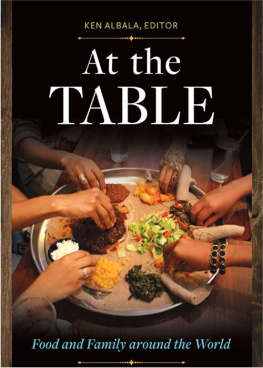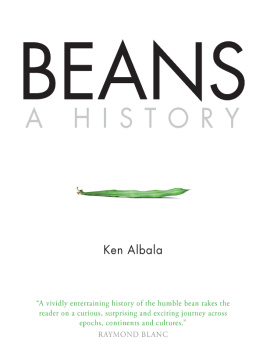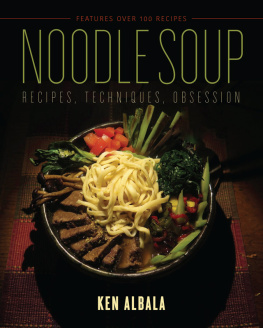

Copyright 2016 by ABC-CLIO, LLC
All rights reserved. No part of this publication may be reproduced, stored in a retrieval system, or transmitted, in any form or by any means, electronic, mechanical, photocopying, recording, or otherwise, except for the inclusion of brief quotations in a review, without prior permission in writing from the publisher.
The publisher has done its best to make sure the instructions and/or recipes in this book are correct. However, users should apply judgment and experience when preparing recipes, especially parents and teachers working with young people. The publisher accepts no responsibility for the outcome of any recipe included in this volume and assumes no liability for, and is released by readers from, any injury or damage resulting from the strict adherence to, or deviation from, the directions and/or recipes herein. The publisher is not responsible for any readers specific health or allergy needs that may require medical supervision or for any adverse reactions to the recipes contained in this book. All yields are approximations.
All recipes in this volume are reprinted with kind permission from their creators.
Library of Congress Cataloging-in-Publication Data
Names: Albala, Ken, 1964- editor.
Title: At the table : food and family around the world / Ken Albala, editor.
Description: Santa Barbara, California : Greenwood, an Imprint of ABC-CLIO, LLC, [2016] | Includes bibliographical references and index.
Identifiers: LCCN 2015037311 | ISBN 9781610697378 (alk. paper) | ISBN 9781610697385 (ebook)
Subjects: LCSH: Food habits. | Cooking, International. | LCGFT: Cookbooks.
Classification: LCC GT2850 .A83 2016 | DDC 394.1/2dc23 LC record available at http://lccn.loc.gov/2015037311
ISBN: 978-1-61069-737-8
EISBN: 978-1-61069-738-5
20 19 18 17 16 1 2 3 4 5
This book is also available on the World Wide Web as an eBook.
Visit www.abc-clio.com for details.
Greenwood
An Imprint of ABC-CLIO, LLC
ABC-CLIO, LLC
130 Cremona Drive, P.O. Box 1911
Santa Barbara, California 93116-1911
This book is printed on acid-free paper 
Manufactured in the United States of America
Contents
Preface
This book is designed to showcase the dinner table and what it looks like in countries spanning the globe, both visually in a snapshot photograph and in an accompanying richly descriptive text. Each entry illustrates various features of the eating event from start to finish, including who does the shopping, who cooks, who sits at the table and how they eat, what customs or rituals they observe, how the food itself is cooked and served, and even who cleans up in the end. Recipes are also included. The ultimate purpose is both ethnographic and to provide a base for broad comparison across cultures, religions, and social settings. Some accounts stem from the contributors personal lives and some are more fly-on-the-wall accounts of objective observers, but all are based on direct experience with the culture covered.
Eating habits are said to be in flux given the changing nature of the family itself, owing to shifting work schedules and the advent of convenience foods and takeout. For many people the breakdown of the family dinner table is seen as directly connected to the demise of the fabric of society. This book is designed to see if this perception of radical change is true and see how, despite so many challenges, people manage to hold on to the family dinner. In some cases they do not. In some cases a family may be construed quite differently than we might expect, and in many cultures there is no table at all. What might be considered proper table manners in one place hardly passes muster in another, and, of course, utensils vary widely from place to place; fingers often work perfectly fine. This is the beautiful diversity of our experience in eating.
Other variables considered include the time of dinner, where people physically eat (in a dining room, in the kitchen, in front of the TV), and whether everyone eats the same food. Dieting, allergies, aversions, and preferences according to age sometimes make serving a common meal an extraordinary challenge for the person in charge, which nowadays is not necessarily the mother of the family. The dynamics of dinnertime conversation are equally as fascinating: some families discuss how their day went, others bicker and fight, and some eat as quickly as possible so they can attend to other things. The purpose here is to examine why these dynamics differ so widely from place to place and what it reveals about each culture.
The examples are in no way meant to be representative of each country, as if that were even possible. Rather, they are simply snapshots of unique, sometimes quirky ways people eat dinner. Nor could we cover every place on the globe. Some stories are located in prosperous cities, some in rural settings. There is a broad range of socioeconomic circumstances featured across the entries, and there are even two contrasting examples from one country precisely for the purpose of detailed comparison. Regarding the culinary landscape, the intent is not to highlight exemplary fine dining and certainly not to stereotype any particular set of customs or eating habits or even feature so-called typical dishes. Rather, the intent is to celebrate the panoply of human experience. The same goes for the structure of the family itself, and the majority of examples here are anything but the perceived norm of a heterosexual couple with 2.5 children. Families are made up of a wide array of relatives, friends, and even solitary individuals. And we must not forget that pets are also often an integral part of the family, even if not fed directly from the table.
At the center of all controversy over dinner is cooking itself. There is a widespread perception that people in the past few generations have lost basic cooking skills and have succumbed to the enticements of mass-produced convenience food that promises to be quick and easy but offers little in terms of gastronomic pleasure or sound nutrition. Moreover, food specifically marketed toward children is thought to be corrupting their palates toward nuggetized, overly salted, and sweet mass-produced food that steers them away from ever appreciating fresh fruits and vegetables and simply prepared dishes made from fresh whole ingredients. Modern industrial food has little respect for culinary traditions, which many see as in danger of being lost. This is thought to be a process begun in the more prosperous nations that has begun to affect the entire globe. We shall see if this perception is true. People may indeed cook differently than in the past, but by and large they are still cooking. One also has to wonder if our perception of a golden past where mom did the cooking from scratch and everyone sat down every night to a quintessential family dinner has more to do with our hopes of what should be rather than what ever really was the norm. The entries that follow provide some evidence that our perceptions are rarely borne out by actual experience. Naturally these accounts offer a tiny statistical sample, but they do show that we should resist making quick judgments about general trends in eating habits and that while the evolution of dinner is inevitable, it is not always so negative.
Another feature that is particularly interesting is how the cooking is done and what technologies are employed. Do families increasingly rely on frozen or canned foods, or is everything fresh and prepared from scratch? Is food purchased once a week and stored in a refrigerator, or is shopping a daily affair? Even the physical layout of the kitchen can be very revealing. Expensive trophy kitchens may rarely be used, while some people seem to manage fine with a tiny burner, a few pots, and a minuscule workspace. It is also amazing that while in one part of the world life seems inconceivable without plastic wrap, tin foil, and plastic containers for leftovers; in other places there arent even refrigerators. We tend to forget that modern modes of eating are not even a century old, and in some places on Earth they are still unheard of.
Next page
















